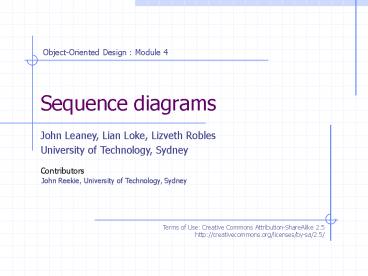Sequence diagrams PowerPoint PPT Presentation
1 / 22
Title: Sequence diagrams
1
Sequence diagrams
Object-Oriented Design Module 4
John Leaney, Lian Loke, Lizveth Robles University
of Technology, Sydney
Contributors
John Reekie, University of Technology, Sydney
Terms of Use Creative Commons Attribution-ShareAl
ike 2.5 http//creativecommons.org/licenses/by-sa/
2.5/
2
Overview
- Last OO design session, we represented the static
structure of the model for a system in a UML
Class Diagram - Classes, generalization, association
- This week we will look at UML Interaction
Diagrams - Sequence diagram
- Quick-and-dirty version
- Collaboration diagram
- Referenceshttp//www.softwarepractice.org/coursew
are/index.php/design/sequence_diagrams
3
Diagrams in UML
Use case Diagram
Development Diagram
Statechart Diagram
Views
Activity Diagram
Component Diagram
Object Diagram
Sequence Diagram
Collaboration Diagram
Class Diagram
Knoernschild, p. 55
UML has a lot of different diagrams! Use them as
appropriate.
4
Interaction Diagrams
- UML notation for illustrating
- how objects interact via messages
- the sequence of events and interactions between a
set of objects - A single diagram is typically drawn for a
particular scenario or use case. - Can be used at different stages in system
development. - We will focus on the use of interaction diagrams
at the design stage.
5
Common Notation
- Classes and Instances
Client
Client
c1Client
instance
named instance
- Message notation
return value message(parameter
parameterType) returnType
s calculateSalary(hours) s calculateSalary
(hours Integer) Double
6
An example sequence interaction diagram
Scenario Check campaign budget
Note The blackened segments show when the object
has the focus of control. You do not normally
show this on your diagrams.
7
Sequence Diagram
- Shows the sequence of events that occur in a
scenario - Shows the detailed interaction between objects
- Good for presenting sequence or time ordering of
messages - Constrained format in which more objects are
added to the diagram horizontally to the right - i.e., can run out of room on the paper
8
Sequence Diagram Notation
- Messages
- Focus of control and activation boxes
- Illustrating Returns
- Messages to self or this
- Creation of instances
- Object Lifelines and Object Destruction
- Iteration or looping
- Conditional messages
9
Notation Samples 1
synchronous message synchronised with source
by a return messagein context of overall normal
message flow
anonymous objectnot named
Client
getName ( )
Activation boxWhen this message trace is active
return message
object lifeline
10
Notation Samples 2
instance creation message
Campaign
named object
addNewAdvert( )
synchronous message
create( ) ltltcreategtgt
adv1 Advert
autoDestroy()
message to self
object destruction
X
11
Notation Samples 3
12
Notation Samples 4
A
B
C
calculate (x )
xgt10calculate( )
xlt10 calculate( )
Mutual exclusive conditional messages
13
Synchronous and Asynchronous messages
Time constraints are mainly used in real-time
systems
14
Example - Sequence Diagram 2
Scenario Add a new advert to a campaign with
boundary and control classes
15
Quick-and-dirty
- Sometimes we want to quickly sketch the essence
of the interaction without bothering about
correct syntax - Here we present a no-frills way of drawing
sequence diagrams, called Quick-and-dirty - Suited to drawing by hand
- Of course, when formally documenting your design,
you should use formal UML syntax - ? Use Quick-and-dirty sequence diagrams in your
project workbook to explore and present your
design
16
Sample 1 Quick-and-dirty
named instance
anonymous instance
player
hand
Card
valueHand
getValue
totalValue
synchronous message
addCard(aCard)
17
Sample 2 Quick-and-dirty
addAdvert
addAdvertUI
CampaignManager
startInterface
selectClient
asynchronous message
18
Collaboration Diagram
- Shows the messages sent between objects without
the linear order shown in a sequence diagram. - Concentrates on the collaborations between
objects. - Better than sequence diagrams for illustrating
complex branching, iteration, and concurrent
behaviour.
19
Example - Collaboration Diagram 1
Scenario Register payment of a sale
direction of message
first internal message
1 makePayment(cashTendered)
makePayment(cashTendered)
Register
Sale
link line
1.1 create(cashTendered)
first message
parameter
Payment
creation indicated with a
instance
"create" message
Ref Larman
20
Collaboration Diagram Notation
- Links
- Messages
- Messages to self or this
- Creation of instances
- Message Number Sequencing
- Conditional messages
- Iteration or looping
21
Example - Collaboration Diagram 2
Scenario Add a new advert to a campaign
Client is responsible for providing data about
campaigns to AddAdvert
Bennett, Figure 9.13
22
Example - Collaboration Diagram 3
Can show different possible allocations of
responsibility
Scenario Add a new advert to a campaign
Here Client is responsible for providing
AddAdvert with a list of its campaigns. AddAdvert
is now responsible for getting campaign details
directly from Campaign objects.
Bennett, Figure 9.14

